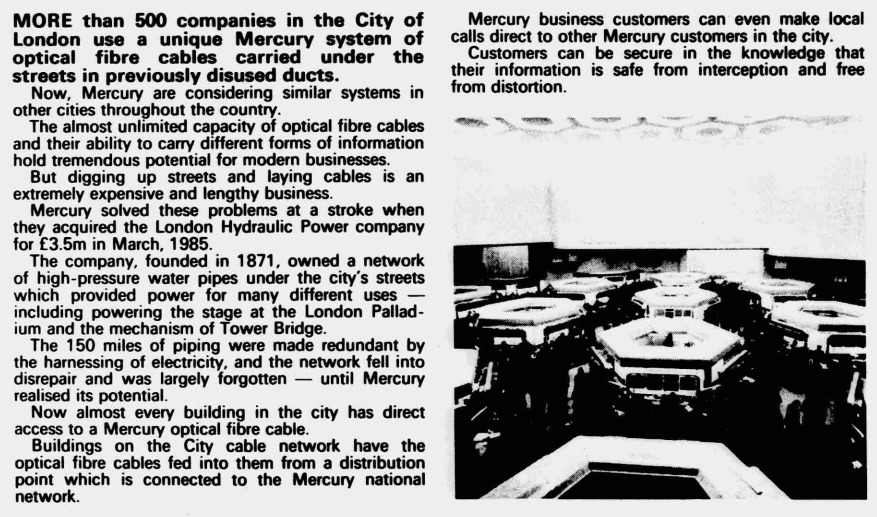A true hidden marvel of London runs under the Thames next to Tower Bridge, a very early railway tunnel, that’s hardly ever been photographed or filmed.
Until now that is.
The Tower Subway is a tunnel dug under the Thames in 1869/70 just to the west of the Tower of London, and was initially intended to be a railway tunnel linking either side of the river. In fact, the railway was a dud, and the tunnel was quickly repurposed into a pedestrian tunnel, which was hugely successful. Until they stuck Tower Bridge next door, and all the pedestrians switched to the bridge.
The tunnel closed to the public in 1898, but it’s still in use, for utilities.
Initially, it was used to pump high pressure water from steam engines on the south side to the north, for use by the London Hydraulic Power Company (LHPC). They had run a large network of largely forgotten pipes under the streets of the City that provided high-pressure water to offices. This wasn’t for drinking, but was for power — to move hydraulic cargo lifts and the like. In the days before electricity, London ran on high pressure water.
Of course, electricity killed off the need for hydraulic water, although it took until 1977 for the company to close completely.
However, it left a legacy — all those small pipes running under the City of London, and something very useful at the time when such things were hard to get, the legal powers to dig up roads.
In 1982, a group of investors bought the defunct company along with the Thames Subway tunnel as they realised that if British Telecom lost its monopoly in the UK (as it was to), then one of the new companies would want to deploy a lot of fibre optic telecoms cables across London.
So it was that in 1985, Mercury Communications – owned by Cable & Wireless was able to buy the company, and used all those Victorian water pipes to lay its fibre optic cables in. And they used the Thames Subway tunnel to link the north and south sides of the Thames with telecoms links.
And they still do — although these days Cable & Wireless is owned by Vodafone.
You can see the northern entrance to the tunnel as a round brick building next to the Tower of London, and the southside is an otherwise anonymous looking shed behind an office.
But for decades, that’s all people have seen of the tunnel.
Until now, as Vodafone has released a film of the inside of the tunnel.
I think this is the first time footage of the inside of the tunnel has been public since Adam Hart-Davis was allowed inside in 2005.
Vodafone is actually showing off how they still need telecoms cables for their network and some of the infrastructure that supports those cables, and how even Victorian tunnels are keeping our mobile phones working today.
But it’s also a very rare chance to see inside the Tower Subway Tunnel.
Enjoy two minutes of tunnel joy.
(please don’t mention illegal break-ins in the comments below, your comment will be deleted)









This brings me back as a 16/17 Yr old I was working for a CCTV drain & pipe survey Co up the road from me in Guildford, We did all the camera surveys on the old victorian cast iron pipes, obviously being 16 I didn’t appreciate what we were doing “Fibre optics which will revolutionise the City & financial markets globally” I remember one of the other contractors telling me they had an access key to the tunnel and I was chomping at the bit! Sadly never got to see it, will definitely check out YouTube for your video Cheers Jim
When I moved to London in 1973 one of the temporary jobs I had was at a fur warehouse on the south bank of the river. The lifts there were hydraulic powered — there was a rope running from from from top to bottom of the lift shaft through holes in the centre of the car’s ceiling and floor. You pulled on the rope one way to go up and the other to go down. It was a gentle pull which you could do with thumb and index finger. It all worked very smoothly.
There’s another underwater tunnel in the area. It’s the turning tunnel for Bakerloo trains allowing them turn round at Charing Cross before the line was extended to Waterloo. It’s is flooded.
Embankment isn’t particularly near Tower Bridge, and you’re probably thinking of the Northern line, not the Bakerloo line.
https://www.ianvisits.co.uk/articles/the-northern-line-tunnel-that-was-bombed-and-flooded-in-1940-and-is-still-sealed-shut-5331/
I was working at Cable & Wireless during the 1980s and was
given a tour through the tunnel. The south entrance was hidden between the River and Tooley Street. I walked the full length to the sealed Tower Hill exit, although daylight could be seen, and back. C&W had not long taken it over and I was conducted through by one of the original staff members.
It would be great if the tunnel could be added to the London open day list. Probably to hazardous though.
Amazing. I did know about it as used to live fairly near it but never seen inside before. Coincidentally I used to work for Cable & Wireless
It is a useful feature for dating maps of London as any that show it must be after 1868. It seems to have had a variety of names: Thames Subway on 1875 and 1890 maps by Bacon, Tower Subway on an 1895 map by Reynold, City and Southwark Subway on a 1902 map by Bartholomew, and just Subway on the map that accompanied the 1915 Post Office Directory by Kelly. After its closure it should have disappeared off the maps as it was just a utility pipe (albeit with a quite a bit of history).